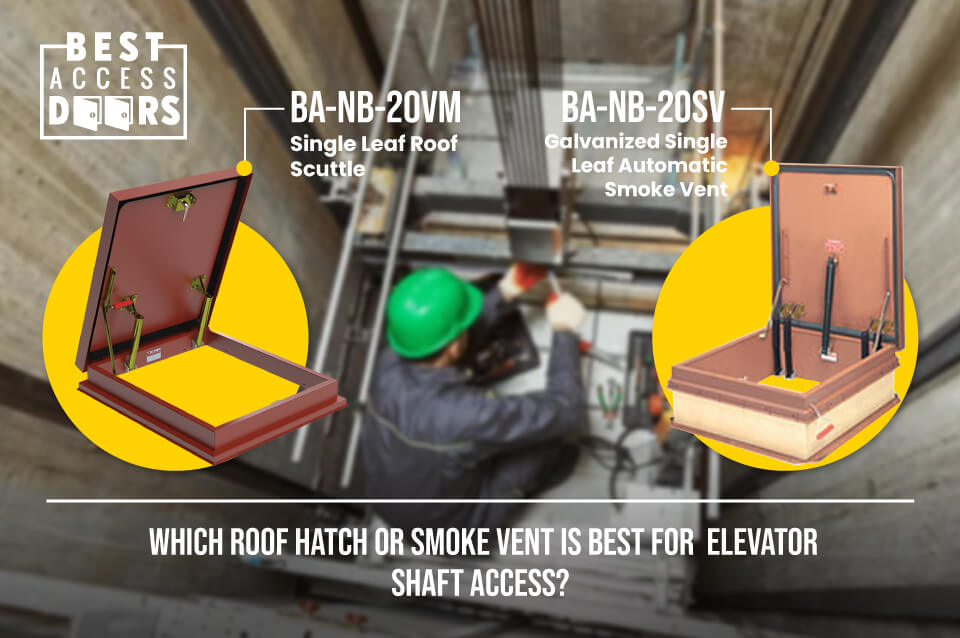Which Roof Hatch or Smoke Vent is Best for Elevator Shaft Access?
Posted by Best Access Doors on 5th Jul 2023
If you're a firefighter and lives are on the line, elevator smoke vents are vital. Smoke vents create a pressure differential that draws smoke and hot gases out of the elevator with louvers and dampers to control the flow with positive pressure fans (PPV) to tactically direct gases, smoke, and flames using natural movement and lift. Depending on the severity of the blaze, proper ventilation in an elevator roof can reduce the need for vertical ventilation procedures, which often causes irreparable damage to the structure.
If you're unfamiliar with the term, vertical ventilation is a tactic used to remove super-heated toxic gases and smoke by clearing their natural path upwards. Firefighters get on the roof and punch through the ceiling to release highly pressurized smoke and flames from the structure, possibly saving lives, although the building may not be salvageable.
Why Both Are Essential
From a firefighter's perspective, a smoke vent is essential for elevator shaft access during a fire. However, building codes require service access elevator roof hatches to provide safe and easy access to the top of the elevator car for maintenance and repair purposes. Minimum size, height, and safety requirements for elevator roof hatches guarantee compliance with building code regulations.
Smoke vents and roof hatches play essential roles in elevator shaft access, but understanding the differences is the first step.
Elevator Roof Hatches for Service Access
A roof hatch may include a ladder inside the elevator shaft. It's typically locked from the outside and opened with a key for service and repairs. As discussed, a smoke vent in the elevator's roof releases smoke and heat in the event of a fire. Firefighters may use the roof hatch to quickly access the elevator's interior if people are trapped inside. The smoke vent can work in tandem by removing smoke and heat from the shaft and creating a clear escape path for occupants.
Roof hatches in elevator shafts are typically rectangular or square-shaped access panels installed on the roof surface. Built with aluminum, steel, or other durable materials, they are typically corrosion-resistant with tight gasketing. They're typically equipped with safety features such as guardrails, safety latches, and skid-resistant surfaces to ensure safe access to the top of the elevator car for service and repairs.
Roof hatches in elevator shafts are typically manually operated and can be opened from the roof using a latch or handle. They may come with pneumatic or electric openers enabling remote operation. Roof panels are designed to be easy to open and close and often come with gas springs or counterbalance systems that help to reduce the effort required to operate.
Elevator Smoke Vents for Ventilation
Meanwhile, smoke vents in elevator shafts are commonly rectangular or circular-shaped structures that automatically open in case of a fire. They release smoke and heat while preventing water from entering. Smoke vents can be gravity-operated or mechanically operated, often furnished with louvers or dampers that authorized personnel can adjust to control the smoke and heat discharged.
Smoke vents in elevator shafts meet fire safety regulations and allow safe evacuation by clearing the smoke in an emergency. Building codes define the minimum number, size, and location of smoke vents to ensure compliance with safety standards. The design and operation of smoke vents are subject to safety standards to certify their effectiveness in case of a fire.
Check Your Local Codes
Many roof hatches and smoke vents carried by Best Access Doors are customizable to include louvers built into the curb for continuous building ventilation. Check your local codes since many areas require smoke vent curbs with built-in louvers to meet elevator shaft code requirements.
Ask us about our BA-NB-20VM roof hatch with optional curb option-built-in louvers!
Your Best Choice for Elevator Shaft Ventilation
When customers ask our product experts which model best suits elevator ventilation requirements, we recommend the BA-NB-20SV Single-Leaf Automatic Smoke Vent. This model is suitable for small and cramped spaces, like elevator shafts, where building codes require proper ventilation while also giving firefighters an attack point to confine flames. You can rest assured that BA-NB-20SV meets International Building Codes, precisely the requirements under IBC 3004.1 and IBC 3004.2.
Why Choose BA-NB-20SV Smoke Vent?
- Easy to Install
- Reinforced Durability
- Smooth Operation
- Fire Code Compliance
- UL-Listed (UL 790 Class A)
- Professional Appearance
BA-NB-20SV Single Leaf Automatic Smoke Vent offers a reliable solution for elevator shaft ventilation. Its automated unlatching mechanism and 14-gauge steel construction make it durable and easy to install. This unit limits the lateral spread of fire and creates a point of attack for firefighters while protecting against secondary ignitions. The vent hatch also reduces noise and minimizes the spread of flames to surrounding buildings. The BA-NB-20SV has a Class A rating, is weatherproofed for insulation, and offers corrosion resistance. Fortify your commercial building with the installation of BA-NB-20SV today!
We want to work with you!
If you have questions, require customization, or want to place an order, our product specialists are ready to help. Just call us at 1-800-483-0843 to get started!
Share our story - the 2025 version is available

 Feedback
Feedback
